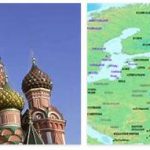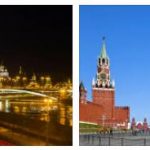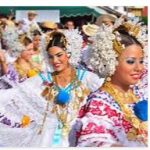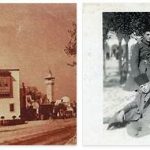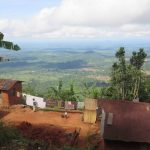The territory of Russia represents, like those of Eastern Europe in general, one of the most recent areas of population, in the context of the old world. At the beginning of the nineteenth century it is probable that there were not yet a total of 10 residents per sq. km, with a maximum of 35 million residents who settled within the current European borders. Around 1850 this population was just over 57 million souls; with the abolition of slavery (1861), rapid and continuous development began. From 63.7 million residents in 1860, in fact, it passed to about 78 ten years later, to 89 in 1880, to 95 in 1890, to 103.5 at the beginning of the century. XX, which represents an increase of 196% between 1800 and 1900, which is the highest value recorded among the European states.
With all this, the current densities, both of the entire USSR (7.8 residents per sq. Km.), And of its European portion (27, a value five times smaller than the Italian one, and in Italy referable only to the province of Nuoro, the least populated of all), are rather low; the latter, one of the lowest on the continent, when the finite fennoscandic sector is excluded. However, it is necessary to take into account not only the extent of the surface areas, to which those figures bring us back, but also the fact that, even without leaving European Russia, there are large uninhabitable sectors, or habitable only by nomads, and others in which colonization is still in place. Therefore the mean values result from far-off extremes. The highest correspond to the areas in which there is ancient or recent development of industries. Figures over 100 residents per sq. km. they are exceptional: they are marked by the district around Moscow, and the one that along the Donets is centered in Charkov (regardless of the two cities). Values between 60 and 100 residents per sq. km. are registered in almost all Ukraine (whose density was in 1933, in total, over 72 residents per sq. km.) and in a large strip of central Russia that links Ukraine to the Moscow region (former governments of Kursk, Orel, Tula and Tambov). The agricultural territories of the center give figures ranging between 40 and 60 (43 overall in White Russia); between 25 and 40 the Ukrainian steppes, the sector of NO. and the area between the lower Kama, the Volga and the middle Urals. Towards E. and especially towards N., on the other hand, the values tend to decrease rapidly: the entire territory beyond 60 ° N. has indices of less than 1 residents per sq. km. (has indexes of less than 1 residents per sq. km. (has indexes of less than 1 residents per sq. km. (i in the Kola peninsula, 2 in Karelia), except in the Baltic selvedge between the Dvina and the great lakes, where it oscillates between 5 and 10 at the most, the latter figures returning to the Kyrgyz steppe and increasing not much along the lower Volga.
The great mass of the population is represented by sedentary people; however, even leaving aside real nomads, such as the Kalmyks, living among the Ergens and the lower Volga (about 300 thousand), and the Kyrgyz, who push their outposts on the Circumcaspian depression between the mouths of the Ural and the Volga (perhaps about 100 thousand), it should be remembered that internal migrations, among Russian peasants, take on a very different frequency and importance than in the Italian regions, caused as they are not only by the well-known phenomenon of urbanism, which has recently accentuated, but also by the different distribution and seasonal concentration of agricultural work. Moreover, the frequent famines that afflict the southern regions (sadly famous, among the recent ones, that of 1921, which caused the death of no less than 7 million individuals) – determine the
The relationship between the rural and urban populations and the anthropogeographic significance of this is also quite different from Italy. Until about the middle of the 13th century, only a small part of Russia had city centers (the high valleys of the Volga, the Daugava, the Don and the Dnieper and the central zone between the latter two), and almost exclusively along the rivers, which represented the ancient ways of communication. Ancient settlements (of Mediterranean origin) survived and survived along the coastal selvedge of the Black Sea, but their commercial character contrasted with the essentially military one imposed by necessity on the nuclei of Russian colonization. On the other hand, the development of industry proceeded so slowly, that still in the mid-nineteenth century the population living in centers of more than 5000 residents it formed, in European Russia, just 8% of the total, a share which had risen to 17% in the period immediately preceding the revolution. This, even more than the whirlwind of the world war, resulted in a strong contraction of the urban population (around 40% between 1917 and 1920 under the RSFSR, and in other areas even more), but development has resumed. very fast, in the last decade, in harmony with the energetic impulse given by the Soviet government to industries (five-year plans) and with the growing abandonment of the countryside, where the rural population, also increasing, no longer knows how to meet their needs. While around 1920 there were, in European territory, just a dozen cities with populations over 100,000 residents, the number of these doubled in 1926, to rise to over forty after 1935. In the entire Russian empire there were 14 at the outbreak of the world war ; in the USSR there were 33 in 1926 and about 60 in 1935; by the last two dates the number of centers with more than 50,000 residents it increased from 90 to over 130. Most of these centers correspond to historical and administrative entities that had already established themselves for various reasons in the pre-war period, but not a few developed from small settlements (Prokopevsk, Gorlovka, Nizhny Tagil, etc.), or have even arisenex – nihilo, together with the industries to which their existence is linked (Magnitogorsk). Overall, the urban population has grown in the USSR from 17% in 1917 to 17.9% in 1926 and to 22.4% in 1933.The highest percentage belongs to Transcaucasia (24.1 in 1926; 28.6% in 1933), the lowest in Tadžikistan (4.6 and 8.3% respectively); as for European Russia, the maximum values undoubtedly refer to the central region (Moscow) and Ukraine, with figures that do not, however, exceed the general average (Ukraine: 18.5 in 1926, 21.9% in 1933), due to simultaneous increase of the agricultural population in both areas more dense than elsewhere.
Moscow has become the most populous center of the state, with more than 3 1 / 2 million residents (3,572,000 residents In 1933); about three million is also Leningrad (2,839,000 residents), which fell from 2,300,000 to just over 700,000 residents in 1920-21. Three cities with over 500,000 residents follow. (Kharkov, Kiev and Rostov), three with more than 400,000 (Odessa, Gor′kij [Nizhny Novgorod] and Stalingrad (Caricyn), two with more than 300,000 (Dnepropetrovsk and Saratov) and six with more than 200,000 (Perm ′, Kazan ′, Samara, Stalin [Yusovka], Voronež and Astrakhan). All these centers have overcome the crisis that followed the outbreak of the revolution, actually marking a very rapid increase – comparable in a certain sense to that of some American cities – in the last decade: thus, for example, the population of Perm ′ and Nizhny Tagil more than tripled in the same period, tripled in Stalingrad, almost tripled in Gorky,
The different ages and the different origins of the centers are naturally reflected in their characters. The most ancient still retain traces of the medieval core around which they were formed (the Kremlin, a fortress and sanctuary, usually arranged in an eminent place), if only in the network of concentric streets that mark their subsequent expansion (Moscow, Tver ′, Ryazan ′, Novgorod, Tula, Kostroma). This type is the rule in the middle forest region, which corresponds to the vital core of the Russian state; therefore the cities that represent it are at the same time the richest in traditions and monuments of historical and artistic interest.
More recent, in general, the centers of the steppe zone, where colonization proceeded together with the conquest; their military character, when it has not been canceled by time or by a further development in another sense (industry, commerce), is evident from the regular plan, with streets that branch off in several directions, as well as from the toponymy, which retains a reminder of the existence of defensive works, often entrusted to colonies of soldiers to whom special quarters were reserved (Charkov, Kursk, etc.). The plan of the typically commercial centers is also regular, coagulated around a market or a castle, as happens especially in the NW regions. (Smolensk, Vitebsk, Minsk, Mogilev); quite the opposite, in cities where the oriental imprint is revealed by the characteristic subdivision into neighborhoods, in each of which an ethnic type is prevalent, and by the exaggerated size of the urban area in which small and sometimes sordid houses alternate with large open spaces and gardens (Kazan ′, Ufa). There were few cities with a western aspect everywhere, where, as along the border with Poland and the Baltic states, the influences of the Middle European civilization were more alive and continuous. In this regard, it should be noted that only in a small number of urban centers does street lighting, city aesthetics and above all public and sanitary services (drinking water and sewage) remind us of what is quietly understood by us in the concept of city. As we move towards the east, on the contrary, these are taking on more and more the appearance of villages, and from the villages they are often poorly distinguished,
On the other hand, the variety of types of dwelling is much less, largely linked to the poverty of solid materials, which is matched, overall, by the abundance of wood, which the rivers provide to spread even in the southern areas without d ‘ trees. From the rural hut (the so-called izba), – which is two-storey in the north, single-storey in central Russia, flat-roofed in the steppe region – the townhouse has developed, with insignificant transformations, also in wood, not only in the smaller towns, grown as a rule by simple juxtaposition of unity to unity, but also in the slobody, or eccentric neighborhoods, of the metropolises. Even more abrupt than in the cities of Western Europe is therefore the contrast that, with the traditional buildings, always low and without architectural pretensions, make the modern multi-storey buildings, in concrete or terracotta, which characterize the recent period of industrial transformation of many of the historic centers, which at the same time became workers’ centers.
Apart from a few of the major cities, streets and squares are generally left abandoned, also because they are not intended to perform a function, in terms of continuity and traffic intensity, comparable to Western Europe. On the other hand, rural roads are usually straight and very wide; very often villages have developed there (enormously elongated on them), which, while in the steppe area they present themselves in a centralized form, are divided more and more into isolated nuclei, gradually proceeding towards the N. and especially towards the NW, where (border with the Baltic states and northern Poland) is also a large sparse settlement area.
The natural movement of the population highlights above all a high birth rate, higher, indeed, than in any other state (at least among the largest): the averages pertaining to the various European regions of the USSR, although oscillating from 44% (to approximately) of the RSFR (which also includes Asian territories) to 30-35% of Ukraine, always remain above those of Western European countries. The mortality rates are also higher than in these (from 19-21 ‰ of the RSFSR to 4-16 ‰ of White Russia), but it should be noted that, while the contraction of births is relatively weak in the last twenty-five years (the index for the Russian Empire it was 48.6 ‰ in 1901), that which occurred at the same time in deaths appears much more decisive (mortality touched 31, 7% in 1901). The result is an even more conspicuous active surplus than in the past (on average 22 ‰ between 1926 and 1930), so that the real annual gain of the population of the USSR has returned to exceed, as in the immediate pre-war period, 3 million residents The decrease in the mortality rate is largely due to better hygienic conditions, which have put a stop to epidemics having an almost regular character: thus, for example, deaths from intestinal typhus, which were 2.66 ‰ in 1913, they fell to just 0.88 ‰ in 1926.
The demographic pressure has found and only partially finds an outlet in transoceanic emigration (1.8 million individuals between 1890 and 1914), which has dropped to insignificant figures in our days (just 1200 Russians moved to North America in 1931), the flow of internal migrations is much more intense, including those aimed at Siberia (where over 7 million residents emigrated in the 19th century) and Central Asia.
The ethnic composition of the USSR essentially reflects the events through which the unity of the empire was achieved, and the participation that the various peoples who found themselves opposing or favoring the historical function assumed by the Russians took in this work.. Peoples, whose ethnic and cultural characteristics could be preserved the better, the more refractory or resistant they proved to the process of assimilation, that is to say of Russification, to which they were subjected, until, with the Bolshevik regime, the basis of state organization changed to individuality that were gradually dissolving in that process, the possibility of at least partially spontaneous and autonomous development was returned, or was offered.
It is not easy to put order in the interlocking of peoples and lineages that appear on the ethnographic map of the USSR; least of all to secrete the numerical entity of the single groups within the European territory, both for the mixtures that took place there, and for the lack of reliable statistics that refer to that territory. However, the absolute prevalence of the Slavic element, which accounts for over 78% of the population of the USSR, is even more peremptory to the west of the Urals (central and southern Russia). Of this mass, the numerically most conspicuous group is that of the Great Russians, which essentially occupies the Volga basin and the NW region. since more than 60 ° N. and alone represents more than 2 / 3 of the slave populations./ 4 of the total of the USSR belongs to the Ukrainians (also known as Little Russians, which exceed 31 million residents), just 3.2% to the White Russians (4.7 million residents), both widespread groups over an area somewhat larger than that which forms the corresponding federated republics.
Apart from the other Slavic populations (Poles: 728 thousand residents, Bulgarians 111 thousand, Czechs, Serbs) and from the Baltic ones (Latvians: 151 thousand, Lithuanians) that infiltrate the north-western border, the remainder is mainly made up of Turkotatar groups and Finno-Ugric, followed by Jews, other Europeans and Mongols by numerical importance (always meaning outside the Asian sector). The latter, who are represented by the Kalmyks who survived the last (1630) eastern invasion suffered by Russia and probably do not exceed 90,000, live nomads between Volga and Manyč. Much more numerous non-Slav Europeans, among which the Germans excel, established as settlers in eastern Volhynia, in the Crimea and above all on the Volga, downstream from Samara, where they formed an autonomous republic. The 1926 census raises them to 2.4 million (against 1.2 in that of 1920-21). A strong minority of Greeks (213,000), scattered all over the place, and Romanians (284,000), mainly concentrated in the SW part, settled in Ukraine. As for the Jews, who exceeded 2.6 million people in 1926, it is certain that the greater part belongs to the European sector, and in this to the cities of the S. and the O. (Ukraine and White Russia), where they not infrequently constitute the highest percentage of the population (thus, for example, in Vitebsk, in Minsk, in Mogilev, in Kamenec, etc.). which exceeded 2.6 million people in 1926, it is certain that the greater part belongs to the European sector, and in this to the cities of the S. and the O. (Ukraine and White Russia), where they not infrequently constitute the highest percentage of the population (thus, for example, in Vitebsk, in Minsk, in Mogilev, in Kamenec, etc.). which exceeded 2.6 million people in 1926, it is certain that the greater part belongs to the European sector, and in this to the cities of the S. and the O. (Ukraine and White Russia), where they not infrequently constitute the highest percentage of the population (thus, for example, in Vitebsk, in Minsk, in Mogilev, in Kamenec, etc.).
Of the other two great stocks mentioned, the turcotataro and the ugroinnico, the first prevails numerically, but it must be remembered that the second corresponds to an older ethnic stratum, and, as such, now more differentiated and overall less compact. On the other hand, not only the Russians contributed to its assimilation, but also the Turkish-Tatar populations themselves, who entered the European area during the late Middle Ages.
Of these, the most conspicuous nucleus is represented by the Tatars, which in the whole USSR touch almost 3 million and also on this side of the Urals they appear very widely distributed (Crimea, circumcaspian area), although concentrated above all on the middle Volga, where they constitute an important autonomous republic (Kazan ′). Their kinsmen and neighbors (Middle Volga) are the Chuvashians (1.1 million throughout the USSR), also organized in an autonomous republic (Čeboksary, to the O. of Kazan ′), which are followed by the Bashkirs for numerical efficiency. (713 thousand), settled between the middle Volga and the Urals and spreading up to the upper Tobol. On the other hand, the Kyrgyz people who live as nomads between the lower Ural and the mouth of the Volga amount to a few thousand.
Populations pertaining to the Finno-Ugric group can basically be grouped into three groups, taking into account their current geographic distribution. The most conspicuous mass is that fixed on the middle Volga: there are distinguished the Mordvini (1.3 million), dispersed between the river and the Urals, and the Mari or Ceremissi (428 thousand), settled in N. dei Ciuvasci fra Gor′kij. and Kazan ′ – both organized in autonomous districts -. The second group, or group of NE., Is formed by the Votiachi (504 thousand), established between Vyatka and Kama, by the Komi or Sirieni (226 thousand) of the Pečora, and by the Permians (150 thousand), dispersed in the upper basin of Kama: of the three populations only the last does not correspond to any administrative unit. Less numerous is the north-western group, to which they fall, together with the few Lapps (1700) of the Murmanian coast and the Samoyeds of the Tundra (15 thousand), the Carelî (248 thousand), who moved from the region of the same name to those of Novgorod and Kalinin, the Estonians (155 thousand) and the Finns (135 thousand), residents in the circumbaltica area. Of these only the Carelî live together in an autonomous republic.
There are no recent statistical data referable to the European territory, and even those relating to the various political-administrative units of the USSR differ greatly depending on the sources. But there is no doubt that the percentage of the working population engaged in agriculture than in any case in European Russia the 4 / 5(including in this item also those involved in forestry and fishing: for the entire USSR it is not far from the truth, fixing it at around 83-85% (91.3 in White Russia, 83.9 in Ukraine), figures which substantially correspond to those of the pre-war period. Industry and handicrafts absorb around 6%, trade and transport around 3% of that total; the rest (6-7%) is up to public administrators (2.2%), the armed forces (0.8%), the liberal professions (0.2%), domestic services, etc. (2-3% unspecified).

